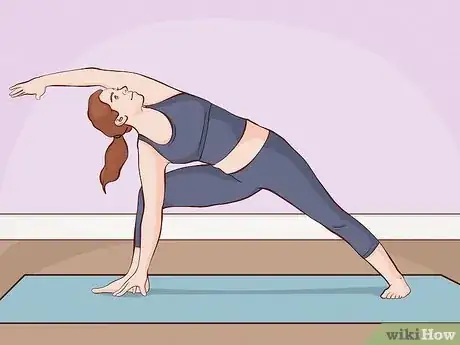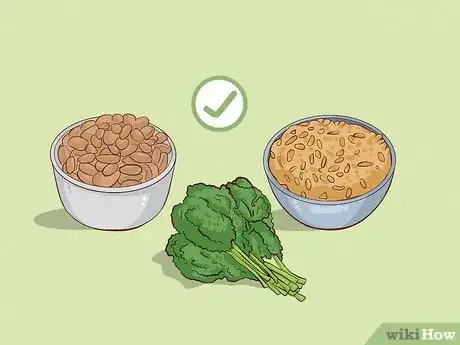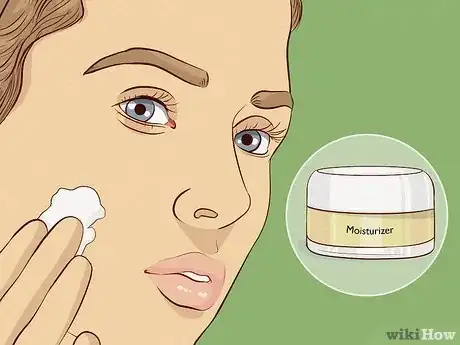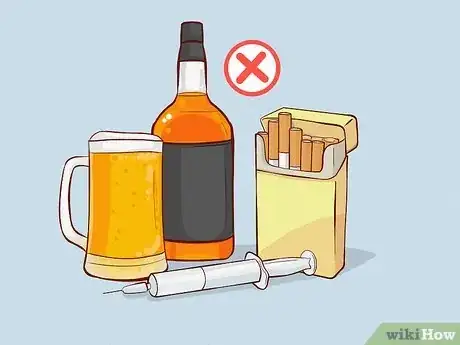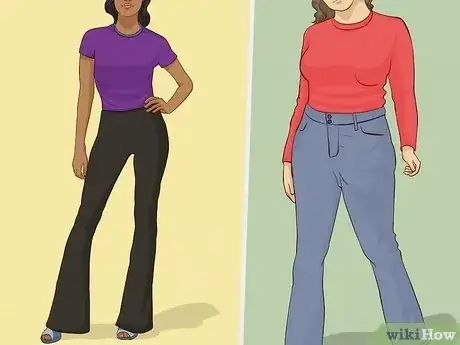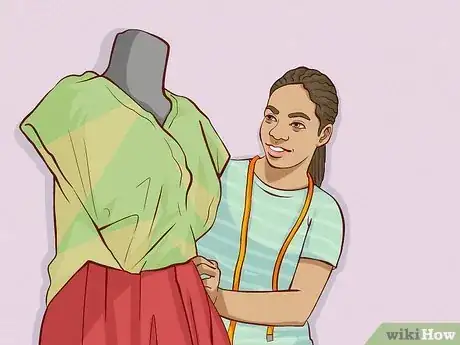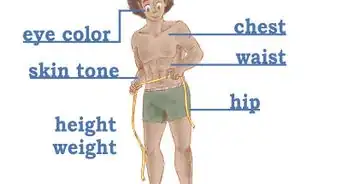This article was co-authored by Melynda Choothesa. Melynda Choothesa is a Costume Designer, Wardrobe Stylist, and Art Director with over 10 years of fashion consulting experience. She has worked on creative direction for fashion shows, costume design, and personal wardrobe styling, both in Los Angeles, California and internationally for clients such as Akon, Kathy Ireland, and Aisha Tyler. She has an Associate of Arts in Fashion Design from Santa Monica College.
There are 24 references cited in this article, which can be found at the bottom of the page.
wikiHow marks an article as reader-approved once it receives enough positive feedback. In this case, 93% of readers who voted found the article helpful, earning it our reader-approved status.
This article has been viewed 202,561 times.
Runway modeling is a popular career goal. Fashion shows and news clips might lead you to believe that you just need to be gorgeous and graceful to be a success. However, you have to meet certain requirements, work hard, and have a Plan B in case your original goal doesn't pan out. Most importantly, you need to take care of yourself because the world of modeling can be demanding.
Steps
Meeting the Requirements
-
1Research physical requirements. On average, you need to be between 5 feet 8 inches (173 cm) and 6 feet (183 cm) tall. However, if you're short but have a fun-loving attitude and strong work ethic, you can still succeed.[1] Officially, there aren't any weight requirements, but most international fashion models weigh between 110 and 130 pounds (50-59 kg).[2]
-
2Research age requirements. In most cases, you have to be 16 to 21 years old.[4] If you're under 18, you'll need a parent or legal guardian to sign your contract. Depending on the state you live in, you might also need a work permit if you're still a minor.[5] If you're over 21 but look younger, you could still have a chance. However, unless you hit superstardom, you're “too old” by age 23.[6]Advertisement
-
3Work on your walk. On the runway, you need to have perfect posture. Square your shoulders and straighten your back. Relax your hands, but don't let your arms swing too much. When you walk, take long strides, and place one foot directly in front of the other.[7]
- Once you get the walk down pat, practice walking in high heels. Start in low-level pumps. Then, gradually work your way up to stiletto heels.
-
4
-
5Eat right. Focus on fresh, preferably organic, foods. Plant proteins, complex carbohydrates, and monounsaturated (“good”) fats are both filling and nourishing.[8] Good choices include legumes (beans, peas, and nuts), dark leafy greens like kale, and whole grains like long-grain rice and barley.
- If you want to go on a diet, talk to your doctor first—even if you're in perfect health.
- Never starve yourself. If you think you might have an eating disorder, call the National Eating Disorders Association at 1-800-931-2237 or text “NEDA” to 741741.[9]
-
6Drink plenty of water. The average adult needs about 64 fluid ounces (1.89 L) of water per day. If you exercise vigorously, you should drink more.[10] Talk to your doctor for specific recommendations. In addition to keeping you alive and healthy, water also prevents you from overeating.
-
7Take care of your skin. A healthy diet and exercise program will minimize common skin problems like acne. If you have oily or acne-prone skin, wash your face at least twice a day with oil-controlling facial scrub. If you have dry skin, use a moisturizing facial wash. Wear sunscreen between 10:00am and 2:00pm, when UV rays are strong. Too much UV exposure can cause premature wrinkles, which are a career killer.[11]
- Treat the occasional breakout with a dab of tea tree oil. If acne breakouts remain stubborn, talk to a dermatologist about prescription medications.
-
8Don't abuse drugs. This includes alcohol and nicotine. Getting drunk everyday can damage your liver and your ability to think clearly. Smoking leads to long-term problems like heart disease, emphysema, cancer, and premature ageing. Hardcore drugs like cocaine or heroin are equally as dangerous and deadly.
Getting Exposure
-
1Build your portfolio. Seek out professional photographers to create your headshots, profile poses, full body shots, and back shots. Wear simple form-fitting clothing like a tee shirt and skinny jeans. Too many layers will cover what agents and talent scouts want to see.[12]
- Agents often want to see casual photos in addition to your portfolio. Smile for a few snapshots, but also experiment with other facial expressions.[13]
-
2Choose a market. Most models work in only one or two markets, such as New York or Paris. Different markets have different preferences for body types. Search online and read fashion magazines to figure out which markets are right for you.[14]
-
3Apply to a modeling agency. Contact top agencies like Elite or Ford. Each agency has its own rules on how to apply. If you break those rules, they won't represent you. Check their website before contacting them or sending your portfolio.[15] Typically, you'll apply as a general model and move to the runway after the agency chooses you.
- Expect your agent to have your best interests in mind. They should always treat you like a professional. If you're brand new to modeling, they should advise you on nutrition and fashion tips. You should also expect them to connect you with the best stylists and photographers.[16]
- Beware of scams! Investigate lesser-known agencies through web searches or the Better Business Bureau. Avoid agents who ask for money up front or try to sell you modeling classes or photo sessions.[17]
-
4Don't pretend. When meeting with an agency, just be yourself. Don't wear clothing or makeup you wouldn't usually wear. On the other hand, if your usual look is funky and outrageous, go with that! Whatever your usual look, wear simple form-fitting clothes so that the agent can see your body.[18]
- Make sure you act professional when you're meeting with an agency. Agents want to work with professional, easy-going people.[19]
-
5Meet people outside the agency. Contacts get you work in this industry. Go to networking events, and be very sociable. Talk to your agent and co-workers about introducing you to designers and scouts. Go to runway shows with people who could make introductions.
Succeeding in Your Career
-
1Hire a lawyer. Attorneys can be expensive, but they'll protect your interests throughout your career. Research lawyers with a track record of winning cases for models. Ask other models for recommendations.[20]
-
2Read the entire contract. Never sign off on anything before reading it closely. Some contracts try to force models to compromise their morals or health for certain assignments. If the wording is too complex, have your lawyer review it. Negotiate (or have your lawyer negotiate) with the agent or scout if you're not comfortable with the terms.[21]
-
3Show confidence. Speak up for yourself if someone pushes you to do something you're against. Talk clearly. Don't mumble or speak at a really low volume. You should also use your body language to show your confidence. Straighten your posture, and make eye contact during conversations.[22]
-
4Persevere. Modeling is a competitive industry, so you should be prepared to handle rejection from time to time. You'll also have to deal with criticism. Even if you've been winning beauty competitions all your life, agents and scouts might insult your looks if you don't fit the type they're looking for. Don't let it get to you. Eventually, you will find an assignment that needs someone exactly your type.
-
5Accept the not-so-glamorous stuff. Like any career, modeling has its down sides. Prepare yourself for working late nights and waking up early the next morning. Get used to last-minute changes in photo shoots, constantly guarding your privacy, and spending lots of time just waiting around. You'll also have to learn to deal with the jet lag and loneliness that comes with frequent traveling.[23]
Making a Back-Up Plan
-
1Consider other paths in modeling. While you can control your weight to a certain extent, your height is another story. The good news is that not all models are tall and thin. If you're shorter than 5 feet 5, consider modeling petite clothing. If you have a medium-to-large build, consider modeling plus-size clothing.
-
2Go to college. Even if things do work out, you'll likely need something to fall back on by your mid-20s. Don't wait until you need to make new plans. Start studying while you're modeling or looking for modeling gigs. If you're traveling for work, talk to an academic adviser about online courses.
-
3Consider other fashion-related careers. Modeling isn't the only career in the fashion industry. With a BA in journalism, you can write for a fashion magazine. A BFA in photography and an impressive portfolio could land you a really nice living as a fashion photographer. If you have a knack for figure drawing and fiber arts like sewing, you should think about becoming a fashion designer.
Community Q&A
-
QuestionI am 13 years old ,163cm and I want to be a runway model when I get older. Is exercise bad for your growth?
 Community AnswerHow tall you eventually grow is based on your genetics, not how much or how little you exercise. If both of your parents are tall, you have a good chance of being tall, as well. If you don't grow that much, you can still model petite clothing.
Community AnswerHow tall you eventually grow is based on your genetics, not how much or how little you exercise. If both of your parents are tall, you have a good chance of being tall, as well. If you don't grow that much, you can still model petite clothing. -
QuestionWhat can I do if people keep turning my down when I am trying to become a model?
 Community AnswerStep back and look at what you're doing. Is there anything you're doing wrong? Is your portfolio carefully curated and professional-looking? Do you smile, are you friendly and do you have good references? You also need to consider the fact that you may be applying for the bigger, better modeling agencies when you should begin at a lesser one to gain a reference.
Community AnswerStep back and look at what you're doing. Is there anything you're doing wrong? Is your portfolio carefully curated and professional-looking? Do you smile, are you friendly and do you have good references? You also need to consider the fact that you may be applying for the bigger, better modeling agencies when you should begin at a lesser one to gain a reference. -
QuestionI'm 15 years old and 5'6". Is it possible that I'll be 5'9" by the time I'm 18?
 Community AnswerIt's definitely possible, but it depends on how your body grows, which mostly comes down to genetics. Just remember to eat healthy, exercise, and stay active. Also, you're not too young to apply right now at some modeling agencies.
Community AnswerIt's definitely possible, but it depends on how your body grows, which mostly comes down to genetics. Just remember to eat healthy, exercise, and stay active. Also, you're not too young to apply right now at some modeling agencies.
Warnings
- Don't ignore the signs of an eating disorder! Seek help if you're taking extreme measures to lose weight.[26]⧼thumbs_response⧽
References
- ↑ http://stylecaster.com/how-to-be-a-model/
- ↑ http://abcnews.go.com/blogs/lifestyle/2011/09/fashion-models-by-the-numbers/
- ↑ http://www.cosmopolitan.com/entertainment/celebs/news/a18375/plus-sized-models/
- ↑ http://modelmentors.com/types-of-modeling/
- ↑ http://time.com/6654/age-restriction-laws-on-models-make-a-difference-at-fashion-week/
- ↑ http://www.modelmayhem.com/education/modeling/2055-how-height-weight-and-age-influence-getting-signed-by-an-agency
- ↑ http://style.time.com/2013/02/06/how-to-walk-like-a-model-in-four-easy-steps-qa-with-casting-director-natalie-joos/
- ↑ http://www.cbsnews.com/news/chemicals-in-food-can-make-you-fat/
- ↑ https://www.nationaleatingdisorders.org/find-help-support
- ↑ http://www.mayoclinic.org/healthy-lifestyle/nutrition-and-healthy-eating/in-depth/water/art-20044256
- ↑ http://www.glamour.com/story/skin-care-secrets-models-know
- ↑ https://www.thebalance.com/become-a-fashion-model-2379459
- ↑ http://www.marieclaire.com/fashion/advice/g740/how-to-model/?slide=5
- ↑ https://www.thebalance.com/become-a-fashion-model-2379459
- ↑ http://www.newmodels.com/application.html
- ↑ http://www.modelmanagement.com/modeling-advice/top-10-modeling-agencies/
- ↑ https://www.consumer.ftc.gov/articles/0071-look-out-modeling-scams
- ↑ http://www.marieclaire.com/fashion/advice/g740/how-to-model/?slide=4
- ↑ Melynda Choothesa. Professional Stylist & Fashion Designer. Expert Interview. 17 April 2019.
- ↑ http://attorneys.lawinfo.com/models/
- ↑ http://www.marieclaire.com/fashion/advice/g740/how-to-model/?slide=7
- ↑ http://www.marieclaire.com/fashion/advice/g740/how-to-model/?slide=6
- ↑ http://www.marieclaire.co.uk/fashion/the-10-things-you-didn-t-know-about-being-a-model-118303
- ↑ Melynda Choothesa. Professional Stylist & Fashion Designer. Expert Interview. 17 April 2019.
- ↑ https://www.thebalance.com/should-you-attend-a-modeling-school-2379433
- ↑ http://www.mayoclinic.org/diseases-conditions/eating-disorders/symptoms-causes/dxc-20182875
About This Article
If you dream of becoming a runway model, adopt a lifestyle that supports your dream to get one step closer to walking the catwalk. The fashion industry has a lot of expectations about how runway models should look, so eating healthy, exercising, and taking care of your appearance all come with the territory. When you’re ready to launch your career, find a professional photographer to take some headshots and full-body pictures. As you build your portfolio, contact reputable agencies, like Elite or Ford, to learn how to apply to their agency. Since most high profile models work in either New York or Paris, do some research to decide if you want to move to one of these hubs. To learn how to network to become a runway model, keep reading!



